CAN KUNGFU BE USED FOR FIGHTING?
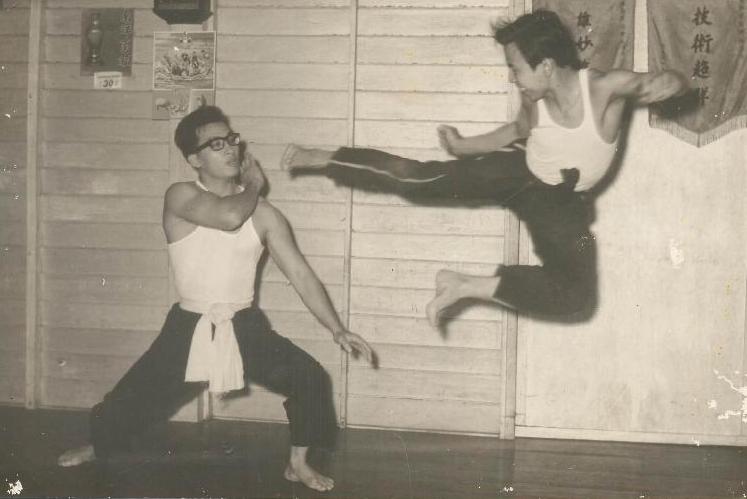
Many readers have asked whether kungfu can be used for combat. This special issue of the question-answer series focuses on the topic.
Question
I saw at an international competition participants of various styles fight like children. Can kungfu really be used for fighting?
JF, Malaysia.
Answer
Your question touches on the essence of kungfu. Yes, there is no doubt that kungfu, if practised correctly, can be used for fighting. Kungfu that cannot be used for fighting is no longer kungfu; at best it is merely a demonstrative kungfu form.
Nevertheless, today an overwhelming majority of those who say they practise kungfu, in both the East and the West, either fight like children or use karate, taekwondo or kickboxing techniques to fight, but not the kungfu techniques that they may perform beautifully in solo practice. (Please note the point here is not their fighting ability, or whether kungfu is better or worse than other fighting arts, but whether kungfu students use kungfu to fight.)
The reason is simply that, in my opinion, they have never learnt kungfu as a martial art as it was traditionally practised in the past. If you merely learn kungfu form, but have never learnt how to develop force and how to spar, you simply have no force and cannot spar no matter how long you might have trained in kungfu form.
Force training and sparring practice have to be approached methodologically and systematically. Skipping over a rope and lifting weights, prancing about and donning boxing groves are not traditional Shaolin ways to develop force and train sparring. It is only sensible that if one wishes to fight like what a Shaolin exponent would do in the past, he or she must train the way a traditional Shaolin disciple did. But for various reasons, many people lack the knowledge or the patience to do so.
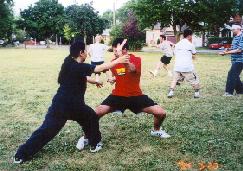
During a sparring session at the Intensive Shaolin Kungfu Course in Toronto in July 2002, after deflecting an attack from Emiko, Eugene is about to execute a low punch in a typical Shaolin pattern called "Precious Duck Swims Through Lotus"
Question
There is something which has bothered me for quite some time. I have observed various types of martial arts. Some include ninjado, northen shaolin boxing, taekwondo and nam wah pai. They seem to lack a certain amount of "essence". Please allow me to explain what I mean.
The various martial arts have excellent techniques and if executed properly, could attack with deadly force. They also help a person keep fit and rank among the most physically demanding sports.. However, all these arts failed a 7th dan taekwondo instructor when he needed it most. He was brutally attacked and killed when he was caught in the middle of a gang fight, and he was only a passer-by.
This incident shook my confidence of martial arts. A person who has practised martial arts for more than twenty years cannot even defend himself against a few men with parangs and broken bottles. What is the use of practising martial arts then? Where are the really useful moves when you need them? Where is the true essence of the martial arts we practise?
I understand that you, Grandmaster Wong, have performed incredible feats, as described in your webpage. I cannot but wonder how the most skilled person in Singapore would fare against you. I believe he would not even and remotely close to you.
Grandmaster Wong, my heart is heavy and my soul is weary. I find it hard to go on in the realm of martial arts. Please advise me as I need help.
Lee, Singapore.
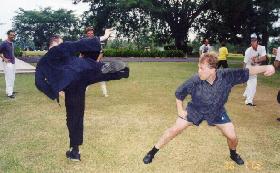
During a sparring session att the Special Taijiquan Course held in July 2002 in Malaysia, Anthony Spinicchia uses a Taijiquan pattern called "Low Stance Single Whip" to counter Jeffry's kick
Answer
Thanks for your e-mail and the kind words you said about me. The so-called incredible feats I performed can actually be performed by anybody if he knows the training procedure and is prepared to train hard for them.
Moreover, although I strongly believe that all those who practice a martial art, any martial art including taijiquan, should be able to defend themselves, I am not a formidable fighter, and I have never aimed to be one.
What I really consider incredible about my training is that it has given me good health, much vitality, mental freshness and spiritual joy. For example, I cannot remember when I was last sick, and I could work energetically from 7.00 a.m. till 12.00 midnight without fatigue.
What I am really proud is that I have helped many people to share such benefits, including helping many people to be relieved of so-called incurable diseases like asthma, diabetes, heart problems and even cancer.
Your remark really touches on the essence of martial arts. For more than 20 years I have been concerned about the inability of most (so-called) kungfu exponents to fight. I do not demand that they must fight well, but the least is that as they learn kungfu, a martial art, they must be able to put up some form of defense even if they lose badly in a fight. The fact is that most kungfu exponents cannot put up any semblance of defense at all, although they may perform their kungfu patterns or sets beautifully in solo demonstrations or arranged sparring.
Nevertheless, this is a very delicate and sensitive issue. While I feel strongly about it, I have to be extremely careful in my expression because not only I do not want to have kungfu people continuously coming to challenge me to test if I can fight, I do not want to hurt the feelings of kungfu "masters" (many of whom are my friends) whom I know cannot fight.
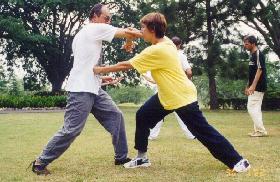
After deflecting Attilio's attack, Laura executes a verticle fist at Attilio's ribs during a sparring session at the Special Taijiquan Course held in Malaysia in July 2002. Why are these exponents able to use typical Shaolin and Taijiquan techniques for combat? They have undergone systemmatic training in combat application.
I wonder whether you have seen any kungfu sparring competitions? They were shameful. Many competitors fought like children; those who could put up some decent fighting, fought with karate, taekwondo or kickboxing techniques. It was more shameful when "masters" employed taekwondo exponents, put on kungfu uniforms and won, and the "masters" claimed them as their own kungfu students.
In taijiquan push-hand competitions, although virtually every taijiquan master and instructor says that taijiquan does not use brute force, virtually every taijiquan competitor uses brute force, and clumsily. The use of weight divisions in kungfu (and taijiquan) competitions is a tacit admission that weight, size and brute force count. The introduction of wushu, the modern form of demonstrative kungfu popularized by present-day China, quickens the transformation of kungfu from a martial art to a dance.
The undeniable fact is that kungfu, including taijiquan, is a martial art, and a very effective one too -- if it is practised as kungfu, and not as kungfu dance. Karate, taekwondo, aikido, judo, boxing and wrestling exponents would be no match against a genuine kungfu exponent. A kungfu exponent would find a Siamese boxer formidable, but if he is prepared to train hard he could beat the latter too.
I must categorically clarify that this statement is not meant to belittle the other arts. In many ways, although I personally do not encourage my children and those who seek my advice to train in these arts, I generally have more respect for exponents of these arts than for those of kungfu. There are a few reasons. For example, these other exponents are true to what they seek, they can defend themselves with their arts, and they are prepared to undergo tough training, whereas those of kungfu do not know what they are doing or are deceiving themselves and others.
For a long time I have wanted to train a team of genuine kungfu fighters who can show the world that kungfu can be used for fighting. It doesn't matter if they lose so long as they use kungfu skills and techniques, and fight honorably. But for various reasons I still have not been able to do so. It is not easy to gather a group of young men (or women) ready to train hard everyday for three years. Secondly, this project will involve much cost.
But probably the most important reason is my scale of priority. Personally, although I have strong sentiments over it, I do not believe that nowadays combat efficiency takes top priority in kungfu training. I do not want to subject my students to training hard for something I do not give top value for. I always want my students to get the best, and the best is good health, vitality, mental freshness, spiritual joy irrespective of religion, and a zest for living. Moreover, I feel the time for me to train a fighting group would be better spent to help patients cured of cancer and heart problems.

If kungfu practitioners, including international form champions, attempt free sparring without prior systemmatic combat training, they will be uable to use their forms for combat, irrespective of how many years they may have practised their forms.
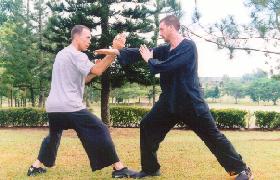
One important method of systemmatic combat aplication is training in combat sequences,, as demonstrated here by Roberto and Jeffrey during the Special Intensive Taijiquan Course in Malaysia in July 2002. From the "Pushing Hands Ready Mode", Jeffrey thrusts out a pakm strike at Roberto, who responses with a "peng" technique.
It is sad that the taekwondo master you mentioned was brutally killed. It is not easy to fight against a group of armed attackers, but I agree with you that a martial art master who has trained for 20 years should be able to come out alive when attacked by a few armed attackers. Perhaps his death had something to do with his martial art philosophy. Korean and Japanese martial artists generally believe that it is an honour to fight, even to death. If a Japanese master were sparred his life by his attackers, he might even kill himself, not just to escape the shame of defeat but to die in honour for his art.
Chinese martial art philosophy is different. There is nothing honorable about killing oneself or being killed by others. If you cannot fight for your life, you have to run for it. It is not just an honour, but a joy to be alive.
This difference in philosophy can be traced to their different histories. Japanese martial arts were developed by samurais, who were actually cold-blooded assassins, ready to kill or die for their lords. Korean martial arts were developed at a time when the country was oppressed by Japanese colonialists, and Korean masters were ready to die fighting the oppressors. In contrast, Shaolin Kungfu were developed by Buddhist monks whose hallmark was compassion, and taijiquan by Taoist priests whose preoccupation was immortality. Both Shaolin and taijiquan masters loved life, their own as well as others'.
I wish to share another secret with you. My master Sifu Ho Fatt Nam, who had dedicated his life to helping others, was once attacked by more than 30 armed attackers whose objective was to kill him and his family for reasons I would not disclose here. He fought them off. My master could have killed their leader and some other assassins (which was actually easier and safer than fighting on) but he let them go. This incident, which happened before I met my master, has great significance for me. It confirmed not only that kungfu can be used for fighting, but that Shaolin masters are compassionate, even at times when doing so might risk their own lives.
Strictly speaking, and in my opinion, taekwondo, judo, aikido, karate, boxing and wrestling are martial sports, not martial arts. From the perspective of Shaolin Kungfu, no experienced fighters who have survived numerous fights, would fight the way exponents of these sports would typically do. Kicking high, for example, not only exposes your vital organs to be bashed, it is technically inferior. For instance, high kicks distort good balance and minimize the effective use of other striking parts like the other leg, the two hands, shoulders, hips, etc.
If you have seen a judo match, you would have noticed how long it takes, even for a judo expert, to throw his opponent. If the opponent just jabs two fingers into the expert's eyes, or, less brutally, kicks hard at his shin, he would have foiled the expert's throw. But of course for those who are untrained, or who are trained in kungfu dance, such kicks and throws as well as martial techniques of the other sports would be formidable.
Yet, while genuine kungfu is very effective for fighting, combat efficiency is not its best benefits. We should of course be able to defend ourselves, but if we place undue emphasis on fighting, it would distract us from other more noble aims.
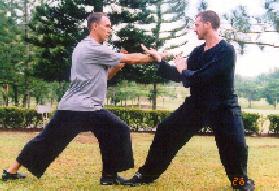
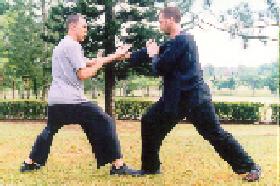
After warding off Jeffrey's palm strike in a circular manner, Roberto counter-attackes with another palm thrust, and Jeffrey responds also with a "peng" technique followed by yet another palm strike, which Roberto again responds with a "peng" technique. It is significant to note that in this training, techniquess are purposely reduced to the minimum so that the practitioners can focus on developing skills. Here Roberto and Jeffry focus on developing the skills of sensing and flowing with the opponent.
Question
I am currently attending Shaolin Kung Fu and have been learning for almost a year. I have read your webpage and book and have a few questions to ask you, if you don't mind. I have only started to spar recently and, although my forms are ok, I find that I end up bouncing around the hall trying to avoid kicks and punches. I have tried to apply the simplest parts of my forms to sparring only to lose my timing and, once walked into a kick to receive two broken ribs!
Does timing only come with practice? Although we are taught attack combinations, no one actually tells us what is wrong with our sparring. I did Tang Soo Do when I was little and it seems that everyone in the class reverts to karate-style punching and kicking when they spar, forgetting the Kung Fu they have learnt.
Is there a systematic way to apply our techniques better to sparring?
Ryan, England.
Answer
Yours is a typical case of people learning kungfu today. It is hard to believe but true that 90% of people learning kungfu today, including in China, do not know how to use their kungfu skills and techniques in combat. Most revert to karate, taekwondo or kickboxing techniques, and many fight like children. If you have read my webpages, you would find this concern is a major theme I have often stressed, but it is a delicate issue and I do not want to offend many kungfu instructors.
The main problem is that the methodology linking set practice and free sparring is generally lost. Going strainght from set practice to free sparring, which 90% of kungfu practitioners do, will result in cases similar to yours. It is not feasible to explain the methodology in a short e-mail, and it is difficult to learn it without a master's personal tuition. Nevertheless I shall try my best to answer your questions. You may also have some useful information on kungfu combat if you refer to my webpages.
I am extremely lucky to have been trained in the traditional Shaoln way, whereby we have to go through numerous stages from set practice to free sparring so that eventually we can sparr in typical kungfu way. I hope to share this methodolgy with deserving students, and may plan an intensive course in Malaysia, but those who wish to particiapate need to be instructors or have practised kungfu for at least three years.
Timing is a crucial factor in combat. Many people think that to win in a fight all you need is techniques. In fact timing is more important than techniques. There is a kungfu saying as follows: bai fa bu ru yi kuai , which means it is better to be fast than to learn hundreds of techniques. If you are fast enough to strike an oppoenent, it does not matter what technique you use. On the other hand, even if you know a lot of techniques, they will be quite useless if you are too slow to use them. But timing is more than just speed. Sometimes if you are too fast, it can be detrimental.
Timing does come with practice, but you must practise methodically. If you practise haphazardly, as many students do, you will still end up bouncing about trying to avoid kicks and punches, although with experience and improved speed you may succeed in the avoiding. But soon you would be out of breath and eventually you would still lose the combat, but even if you win you would be reverting to karate-style punches and kicks, forgetting about all the kungfu you have learnt.
Actually you are lucky to realize this pathetic situation after only a year; many others, including "masters", keep on this pathetic situation for life, and if they do not have opportunites to test out their sparring effectiveness, or ineffectiveness, they may imagine they are doing wonderful kungfu. Those who have some inkling of their combat ineffectiveness would, in an attempt to cover their inadequacy, turn aggressive whenever sparring is suggested, or mystify kungfu as such a deadly art that sparring practice even among classmates is forbidden.

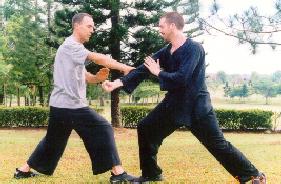
After warding off Jerry's attack, Roberto thrusts out another palm strike. This time Jeffry brushes aside the strike and counter-attacks Roberto's ribs with a verticle punch. Notice that another important factor in this training is the stance. Roberto and Jeffry maintain their typical Taijiquan stances, instead of bouncing about as in Western Boxing. Only when kungfu practitioners have developed both solidity as well as flexibility of their stances, can they use their techniques effectively.
Genuine kungfu exponents are calm and gentle as they do not have to prove to others and, more importantly, themselves that they can fight, because they know they can. Sparring using kungfu patterns must be learnt methodically and systematically, otherwise students will revert to the more simple karate-style punches and kicks, or to the most natural way of fighting as exhibited by children. Kungfu fighting is not natural fighting; it has to be learnt and aquired, and to be practised and practised methodically and systematically until it has become second-nature.
There are many steps between set training and free sparring. Thus, if an instructor or even a "master" asks you to practise sparring just after the set training stage, you can reasonably suspect that he does not know the essential intermediate steps. Set training is to familiarize you with the form and practice of kungfu techniques; free sparring is to put these techniques, as well as appropriate tactics and strategies and other combative factors like force, timing, spacing, judgment and decision--making into action against an opponent or opponents.
Many useful tactics and strategies have been generalized into kungfu principles like "using minimum force against maximum strength" and "avoiding his strength and attacking his weakness". Methodologies like specific techniques, combat sequences and sparring sets are employed to train combative factors to prepare for free sparring.
As there are more things to learn and practise in kungfu than in other martial arts, it is logical that it takes more time. A kickboxer can fight reasonably well after training for six months, a karate or taekwondo exponent in three years, but a kungfu practitioner would need more time. This does not mean that you can't fight until after practising kungfu for more than ten years -- as some "masters" buying time to cover their inadequancy may suggest. In fact if you have practised genuine kungfu -- any style of kungfu including taijiquan -- for a year or two,you should be able to provide some decent defence against any assailant irrespective of what martial arts the assailant may use; otherwise you should examine whether your art is genuine kungfu.
